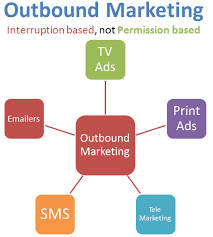inbound vs outbound marketing
In today’s digital age, marketing has evolved significantly, presenting businesses with an array of strategies to reach their target audience. Among the most debated topics in marketing circles are the distinctions between inbound and outbound marketing. Understanding the fundamental differences between these approaches is crucial for crafting effective marketing campaigns and driving business growth. Let’s delve into the intricacies of inbound vs outbound marketing to gain a deeper understanding of their respective strengths and weaknesses.
Defining Inbound Marketing:
 Inbound marketing revolves around the concept of attractingcustomers through valuable content and experiences tailored to their needs and interests. Instead of interrupting potential customers with intrusive advertisements, inbound marketing aims to provide solutions to their problems, thus earning their trust and loyalty over time. Key components of inbound marketing include content creation, search engine optimization (SEO), social media engagement, email marketing, and more.
Inbound marketing revolves around the concept of attractingcustomers through valuable content and experiences tailored to their needs and interests. Instead of interrupting potential customers with intrusive advertisements, inbound marketing aims to provide solutions to their problems, thus earning their trust and loyalty over time. Key components of inbound marketing include content creation, search engine optimization (SEO), social media engagement, email marketing, and more.
Benefits of Inbound Marketing:
One of the primary advantages of inbound marketing is its ability to build long-term relationships with customers. By delivering relevant and helpful content, businesses can establish themselves as authorities in their respective industries, thereby fostering trust and credibility among their audience. Additionally, inbound marketing tends to be more cost-effective compared to outbound methods, as it relies heavily on organic reach and customer engagement rather than paid advertising.
Understanding Outbound Marketing:

Contrary to inbound marketing, outbound marketing involves reaching out to potential customers through more traditional and direct means. This includes tactics such as television and radio commercials, print advertisements, cold calling, and email blasts. Outbound marketing relies on pushing messages to a broad audience in the hopes of generating immediate sales or leads, often without considering the specific needs or interests of individual consumers.
Drawbacks of Outbound Marketing:
While outbound marketing can yield quick results, it is often perceived as intrusive and disruptive by consumers. In today’s digital landscape, where individuals have more control over the content they consume, outbound marketing tactics may be met with skepticism or even resentment. Moreover, outbound marketing campaigns typically require a significant investment of resources and may not always deliver the desired return on investment (ROI).
For Live class watch our video on youtube by click on the below link
Integrating Both Approaches:
While inbound and outbound marketing are often portrayed as opposing strategies, savvy marketers understand that they can complement each other when used strategically. For example, businesses can leverage outbound tactics to raise awareness and drive traffic to their inbound marketing channels, where they can then engage and nurture leads through valuable content and personalized experiences.
Conclusion:
In summary, inbound vs outbound marketing represent two distinct approaches to reaching and engaging with customers. While inbound marketing focuses on attracting prospects through valuable content and experiences, outbound marketing involves reaching out to potential customers through more traditional and direct means. By understanding the strengths and weaknesses of each approach, businesses can tailor their marketing strategies to effectively reach and connect with their target audience in today’s dynamic digital landscape. Ultimately, the key to success lies in finding the right balance between inbound and outbound tactics to achieve marketing objectives and drive business growth.
Also Check our latest uploads

